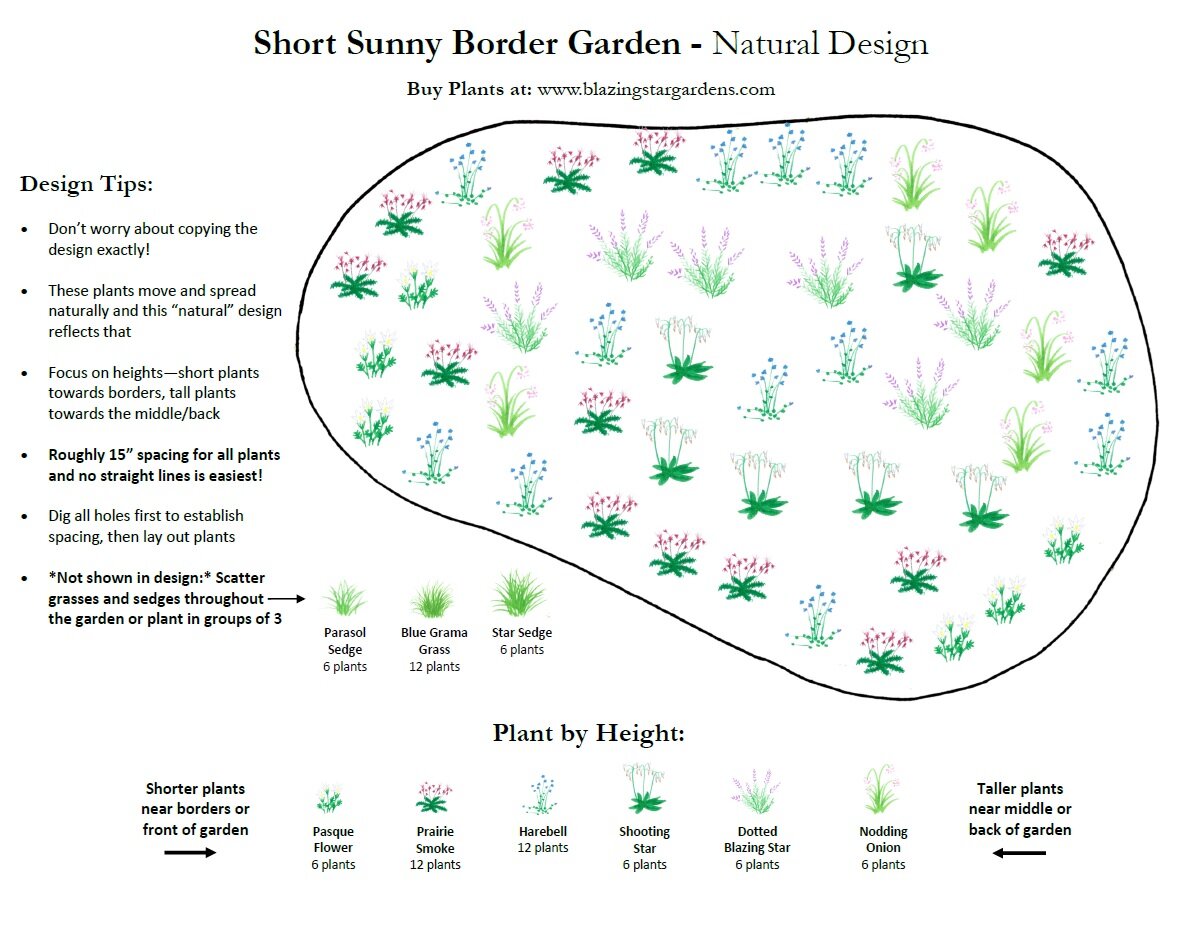
Short Border Garden Design
Garden at a glance:
Sun-loving plants (see list below)
Only short plants for front yards and boulevards
Perfect pollinator garden for beginners
This garden will plant an area from 10ft x 10ft up to 10ft x 15ft
How to design and plant:
This garden has been designed with enough species that no matter where you place the plants, they’ll create complimentary blooms
Mix the grasses and sedges throughout the garden to provide soft textures to balance out the more chunky flower leaves
Plants can be planted 12-15 inches apart
Materials and Supplies:
Plants - you can buy this as a pre-made garden kit or purchase the plants as pots separately. The garden kit is cheaper but the pots are larger, more mature plants.
3” of wood mulch (1 cubic yard, or 14 bags of 2 cubic foot mulch). Wood mulch reduces weeds, reduces watering to just 3-5 times the first year, and nearly doubles plant growth—well worth the extra work (a few hours) and cost (about $40 for a 10ft x 10ft area).
Paper weed-block rolls or cardboard or newspaper to put underneath the mulch. Do not use plastic!
Edging - 5” deep plastic edging or blocks.
Sticks or popsicle sticks to mark the plants. Plastic labels will break over time.
Plants needed:
Flowers:
6 Nodding Onion (Allium cernuum)
6 Pasque Flower (Anemone patens)
12 Harebell (Campanula rotundifolia)
6 Shooting Star (Dodecatheon meadia)
12 Prairie Smoke (Geum triflorum)
6 Dotted Blazing Star (Liatris punctata)
Grasses and Sedges:
12 Blue Grama Grass (Bouteloua gracilis)
6 Star Sedge (Carex radiata)
6 Parasol Sedge (Carex umbellata)
Maintenance:
Weeding. The first two years are really important, so try to weed every few weeks and pull out even the tiniest weeds each time. If weeds get too big, their big roots pulls up clumps of large clumps of dirt and it wrecks the mulch layer. Watch for weedy grasses that seem to be spreading underground inches or feet at a time—these are particularly difficult weeds to keep under control (all of the grasses or sedges stay in clumps and don’t spread underground).
Watering. If you used 3 inches of wood mulch, you’ll probably only need to water twice a week for a 4-6 weeks after planting and then never again! But always be sure to watch for wilting leaves. Never water every day, and always check the soil moisture under the mulch with your finger before deciding if they need water or not. We have never needed to water a native plant garden after the first year of establishment!
Trimming. At the end of the year you can leave all of the stems over winter. Birds will continue to eat the seeds of Dotted Blazing Star and Narrow Leaf Coneflower into early winter. Bees and insect larvae overwinter in stems. The foliage provides winter interest as it sticks out of the snow. You can also choose to cut things back or mow everything down in fall or spring. Cutting things down allows more sun to reach the ground and plant crowns, warming things up faster in the spring and making things re-sprout earlier.
Mulching. If you use 3 inches of wood mulch to start and make sure you pull weeds when they are very small so their roots don’t wreck the mulch layer when pulled, you shouldn’t have to mulch again—the wood mulch will stay intact as the native plants mature and spread over the years. As the native plants get bigger, especially the grasses and sedges, their leaves will create a natural mulch layer at the end of each season.

